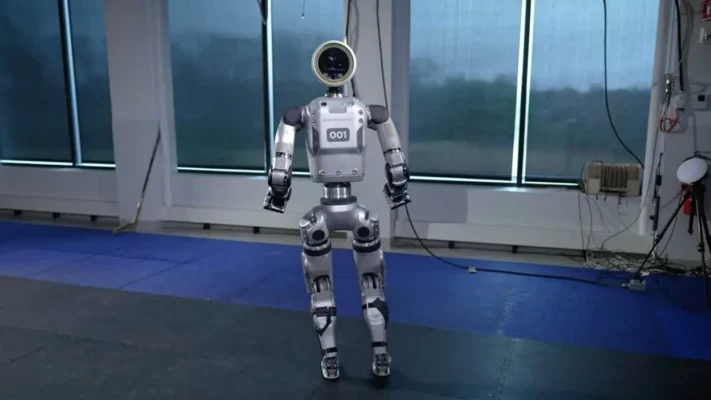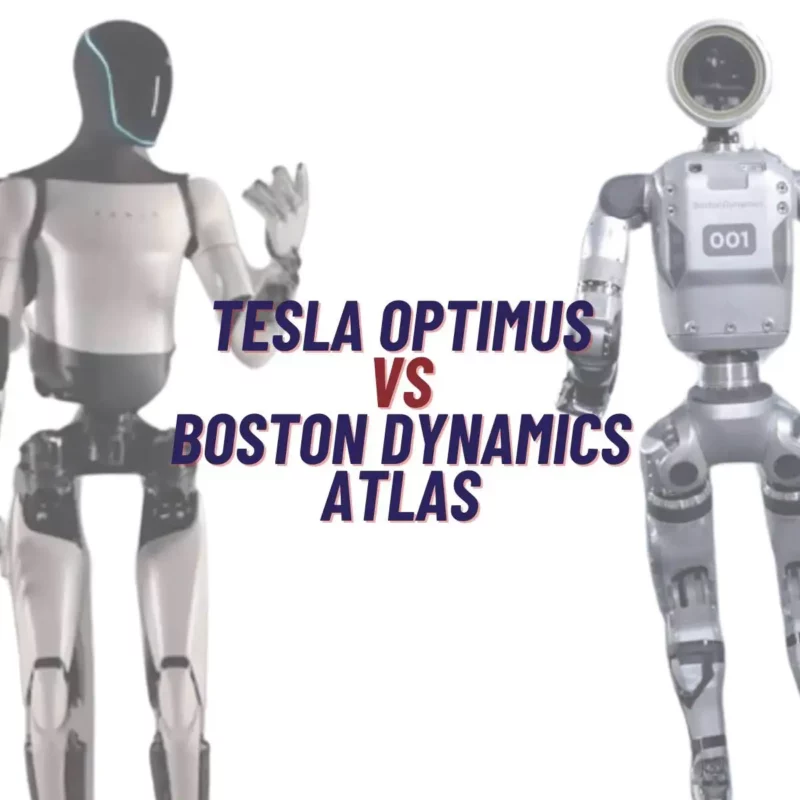When you think about humanoid robots, two names likely come to mind: Tesla Optimus and Boston Dynamics Atlas. These robots represent the pinnacle of robotic innovation, but they serve very different purposes. In this showdown, we’ll dive into what sets each robot apart, from their design and technology to their capabilities and potential applications.
Whether you’re a project engineer looking to understand the latest in robotic technology or simply a tech enthusiast, this comparison will help you see which robot might suit your needs or spark your interest.
Let’s unpack what makes each model unique.
What is a Humanoid Robot?
A humanoid robot is a robot designed to look and act like a human. These robots have a head, a torso, arms, and legs, mimicking the human body’s structure and movement. They’re built to perform tasks in environments made for humans.
Why make a robot look like a person? The idea is to create machines that can easily fit into human environments and use tools or perform tasks just like we do. They can walk, grasp objects, and sometimes even mimic facial expressions or gestures.
Industries like manufacturing, healthcare, and service are already exploring how humanoid robots can assist in their operations, making tasks safer or more efficient. Whether it’s carrying items across a factory, assisting patients in a hospital, or greeting customers, these robots are stepping in to help.
Looking to compare humanoid robots and their prices? Check out Alina on Qviro to explore in-depth comparisons and pricing details for advanced robots like Tesla Optimus and Boston Dynamics Atlas. Alina helps you find the right humanoid robot that fits your specific needs and budget.
Background on the Competitors:
Tesla Optimus:
Origins & Development History:
Tesla Optimus created by Elon Musk and his team, is part of Tesla’s vision for automation. The robot is designed to handle tasks that are unsafe, repetitive, or dull, aiming to transform the workforce.
Key Features & Intended Applications:
Optimus is built to adapt and easily navigate human environments. It can handle tools, carry loads, and perform various manual tasks. Initially aimed for use in Tesla factories, there’s also potential for it to help with everyday chores and tasks in homes.
Boston Dynamics Atlas:
Development Timeline & Technological Advancements:
Atlas, initially funded by DARPA and developed by Boston Dynamics, has significantly improved over time. This robot demonstrates advanced balance and dynamics, designed for both structured and unpredictable environments.
Key Capabilities & Primary Uses:
Atlas is known for its agility and skill in handling complex terrains, able to run, jump, and perform backflips. Primarily developed for search and rescue missions in tough environments, it has also proven useful in construction and delivery, showcasing its versatility as a multi-functional robot.
Design & Technology:
Physical Build & Aesthetics:
Tesla Optimus:
Optimus stands roughly five feet eight inches tall and weighs around 125 pounds. It’s made mainly of lightweight, durable materials like aluminum and plastic. Its design is sleek and minimalistic, reflecting Tesla’s modern style.

Boston Dynamics Atlas:
In contrast, Atlas stands about five feet nine inches tall and weighs 190 pounds. It is made from steel, aluminum, and 3D-printed components, which make it stronger and more agile. Atlas has a mechanical look that matches its powerful industrial abilities.

Core Technologies:
Tesla Optimus:
Optimus uses Tesla’s custom software, paired with sensors and actuators for precise movement and interaction in different settings. It also has advanced vision systems that help it recognize and handle objects, allowing it to perform complex tasks safely.
Boston Dynamics Atlas:
Atlas runs on Boston Dynamics’ specialized software, supporting advanced motion algorithms. It uses sensors like LIDAR and depth cameras, along with proprioceptive sensors, to navigate rough terrains and move dynamically. High-speed motors and hydraulics enhance its processing power, enabling quick and precise movements similar to human agility.
Capabilities & Performance:
Mobility & Flexibility:
Tesla Optimus:
Optimus moves smoothly and can easily navigate tight spaces. It handles objects carefully and can perform a variety of tasks, from simple lifting to complex assembly, making it useful in both industrial and home settings.
Boston Dynamics Atlas:
Atlas is highly mobile, able to run, jump, and do backflips, which makes it ideal for moving through rough terrain or obstacles, like those found in search and rescue missions or construction sites.
Learning & Adaptation:
Tesla Optimus:
Optimus uses Tesla’s AI to quickly learn and adapt to new environments and tasks, improving over time. This makes it a versatile addition to both workplaces and homes.
Boston Dynamics Atlas:
Atlas uses advanced AI to interact with and learn from its environment in real time. This learning capability allows it to handle complex and unfamiliar tasks, essential for working in dynamic environments.
Applications & Use Cases:
Tesla Optimus:
Industrial, Commercial, and Domestic Uses:
Optimus is versatile, able to work not just in Tesla’s factories but also in other industries. It can manage inventory, assist with packaging, and handle maintenance in commercial settings. At home, Optimus could help with daily chores or provide support for elderly care. It’s designed to easily integrate into various environments, simplifying tasks and enhancing safety.
Boston Dynamics Atlas:
Emergency and Difficult Terrains:
Atlas excels in challenging environments, perfect for search and rescue missions where it can navigate through rubble and reach hard-to-access areas. It’s also useful in disaster zones or construction sites, performing tasks like inspections, carrying materials, or making complex repairs. Its durability and advanced mobility make it a vital tool in high-risk scenarios.
Tesla Optimus and Boston Dynamics Atlas show how humanoid robots can be transformative in both everyday and specialized settings. Optimus could become a crucial part of industries and homes, while Atlas could change the way we handle emergencies and navigate challenging terrains. Their potential applications illustrate the significant benefits humanoid robots can bring to various sectors.
Challenges & Limitations:
Tesla Optimus:
Known Issues: Optimus is still being fine-tuned, which means it’s not fully ready to handle unpredictable environments like homes or small businesses. There’s also a question about whether the investment in such advanced technology pays off in everyday settings.
Criticisms: Critics have pointed out that Optimus may not meet Tesla’s promises for autonomy and versatility. In demonstrations, while it handles basic tasks well, it struggles with more complex interactions and unpredictable situations.
Boston Dynamics Atlas
Limitations: Atlas is impressive but has practical limitations, such as short battery life and the need for frequent maintenance, which can limit its use in long-term missions.
Criticisms: The cost of Atlas and its real-world usefulness are often questioned. It excels in controlled tests but faces challenges in real-world scenarios with many unpredictable elements.
Both Tesla Optimus and Boston Dynamics Atlas face significant challenges as they push the boundaries of what humanoid robots can do. They highlight the complexities of bringing advanced robotic systems into practical daily use and emergency situations. Their ongoing development aims to tackle these issues.
Future Prospects:
Tesla Optimus:
Future Developments:
Tesla aims to make Optimus more adaptable and efficient, particularly in handling complex tasks and environments. Future versions will likely focus on advanced AI for better autonomy and interaction with human spaces.
Industry and Societal Impact:
As Optimus gets integrated into more sectors, it could reduce labor costs and boost productivity, leading to new jobs in robot maintenance and programming. However, it might also replace some traditional jobs, prompting a shift in the workforce.
Boston Dynamics Atlas:
Future Enhancements:
Boston Dynamics plans to improve Atlas’s battery life and durability, making it more capable in diverse and harsh conditions. They’ll also enhance its AI for complex decision-making.
Industry and Societal Impact:
Atlas could change how we handle emergency response, construction, and military tasks by improving safety and efficiency. Its use in these fields could save lives but also raises ethical questions about robotics in sensitive situations.
Conclusion:
We explored the capabilities and futures of Tesla Optimus and Boston Dynamics Atlas, two leaders in humanoid robotics. Optimus will transform both work and home environments, while Atlas pushes the boundaries in mobility for challenging settings. As these robots evolve, they will significantly impact various industries, introducing both advancements and new challenges.
Are You Looking to Find Out More About Humanoid Robots?






Tesla is the future.
Twoja zdolność do przekazywania trudnych koncepcji w prosty i przystępny sposób zdecydowanie wyróżnia ten artykuł, co czyni go nieocenionym źródłem wiedzy dla różnorodnej publiczności.
Czytanie Twojego wpisu to jak podróż po malowniczym krajobrazie myśli – pełnym barw, głębi i światła! Jeśli kiedykolwiek zdecydujesz się wydać książkę, na pewno znajdziesz rzeszę wiernych czytelników!